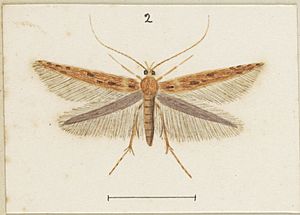Batrachedra agaura facts for kids
Quick facts for kids Batrachedra agaura |
|
|---|---|
 |
|
| B. agaura by George Hudson | |
| Scientific classification |
Batrachedra agaura is a small moth that lives only in New Zealand. It belongs to the Batrachedridae family. You can find this moth all over the country, from the top of the North Island to the bottom of the South Island.
Contents
Discovering the Moth
This moth was first described in 1901 by a scientist named Edward Meyrick. Later, George Hudson, another well-known insect expert, wrote about and drew pictures of this moth. He included it in his books, The Butterflies and Moths of New Zealand (1928) and Fragments of New Zealand Entomology (1950).
The very first specimen of this moth, called a lectotype, was collected by Meyrick himself. He found it near Mount Arthur in the Nelson area. This important specimen is now kept at the Natural History Museum, London.
What Does it Look Like?
Batrachedra agaura is a small moth, usually about 13 to 17 millimeters long. That's roughly half an inch to two-thirds of an inch.
Its head, antennae, and body are often a pale yellowish-white or reddish-yellow color. Its legs are dark, with yellowish-white rings. The front wings can be yellowish-white or reddish-yellow. They often have dark brown or reddish-brown speckles. You might also see three large, dark brown spots on the front wings. The hindwings are usually a darker brown.
The moth has a long, well-developed proboscis, which is like a straw it uses to drink. Female moths tend to be lighter in color than males. The colors and patterns on these moths can vary quite a bit from one moth to another.
Where Does it Live?
This moth is special because it is found only in New Zealand. It has been seen in many places, from Kaeo in the North Island all the way down to Invercargill in the South Island. This means it lives throughout the main islands of New Zealand. It has even been found on Pitt Island, which is part of the Chatham Islands, far to the east of New Zealand.
Life and Habits
Adult Batrachedra agaura moths are usually active from October to February. They are nocturnal, meaning they fly around at night. Sometimes, they are attracted to lights.
When the young moths, called larvae, are ready to change into adult moths, they build a cocoon right where they have been feeding. They then turn into a pupa inside this cocoon.
Home and Food
This moth likes to live in native forests, especially those with beech trees. It also enjoys areas with manuka and kanuka scrubland.
The larvae of this moth are often found near sooty mould and a tiny insect called sooty beech scale. Scientists think that the moth larvae might eat the sooty beech scale insects. However, they might also eat the sooty mould itself. If it turns out that Batrachedra agaura larvae do eat scale insects, it would be very interesting. This would make them one of the few moth species whose larvae are predators.
Images for kids



